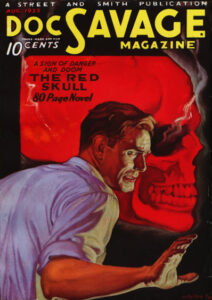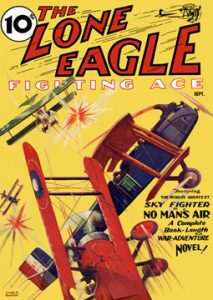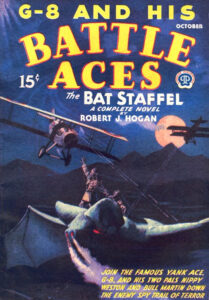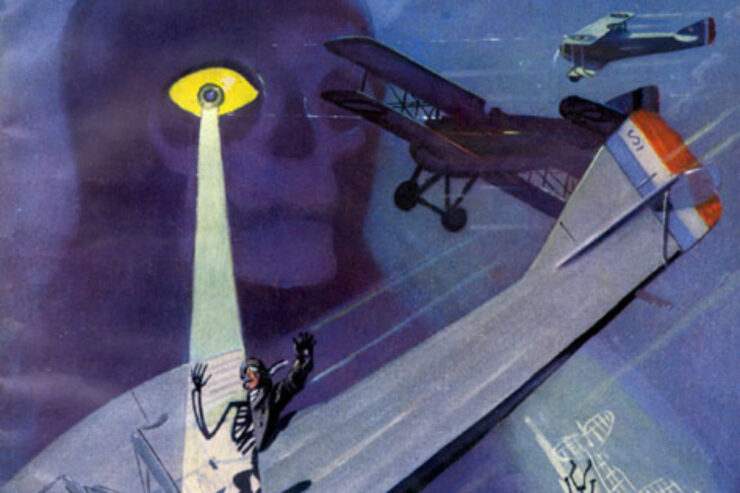 Americans in 1933 had “nothing to fear, but fear itself.” The pulp heroes introduced early that same year were proving the country’s new president to be absolutely correct. The Phantom Detective, Nick Carter, and Doc Savage had met and defeated “The Emperor of Death,” “Maniacs of Science,” “The Red Skull,” and other adversaries. As the year wore on and The Great Depression savaged other genres, the pulp heroes of 1933 surged forward, their magazines flying off America’s newsstands.
Americans in 1933 had “nothing to fear, but fear itself.” The pulp heroes introduced early that same year were proving the country’s new president to be absolutely correct. The Phantom Detective, Nick Carter, and Doc Savage had met and defeated “The Emperor of Death,” “Maniacs of Science,” “The Red Skull,” and other adversaries. As the year wore on and The Great Depression savaged other genres, the pulp heroes of 1933 surged forward, their magazines flying off America’s newsstands.
Among the pulp markets that had been hard hit were the air pulps. But the genre was far from dead.
In 1932, a trio of air-war magazines took flight: Popular Publications’ Dare-Devil Aces and Battle Birds and the Thrilling Groups’ Sky Fighters. Their pages filled with the exploits of flying aces of the First World War, these pulps were “especially sought after by boys raised on the courageous exploits of fathers and uncles who had served in the Great War, boys who kept themselves busy building model planes constructed of balsa wood.”
Little wonder that the next pulp heroes to be introduced in 1933 would take to the air, retelling the adventures of two flying aces of the First World War.
 Borrowing one of the nicknames given to Charles Lindbergh following his nonstop flight from New York to Paris, Standard Magazines was first to the stands with The Lone Eagle. Retelling the heroic adventures of Air Intelligence Agent John Masters, “the world’s greatest Sky Fighter” — as proclaimed on the magazine’s cover — the pulp debuted in the late summer of 1933.
Borrowing one of the nicknames given to Charles Lindbergh following his nonstop flight from New York to Paris, Standard Magazines was first to the stands with The Lone Eagle. Retelling the heroic adventures of Air Intelligence Agent John Masters, “the world’s greatest Sky Fighter” — as proclaimed on the magazine’s cover — the pulp debuted in the late summer of 1933.
“Masters showed a natural affinity for a stuttering machine-gun and as his natural proficiency increased, he built up a dark and terrible reputation about his name. He became the “Lone Eagle” of the skies. . . . He showed an indomitable courage and a dynamic driving power, in pushing to a successful conclusion his secret missions. Many men feared him, many hated him — an occasional one loved him.”
Those words, written by F. E. Rechnitzer, appeared in “No Man’s Air,” the lead novel for the first issue of the new hero pulp. A former World War I allied pilot and prisoner-of-war, Rechnitzer is believed to have written many of the adventures of The Lone Eagle, hidden behind the “Lieut. Scott Morgan” house name. Robert Sidney Bowen probably contributed most of the later novels.
In all, seventy-five tales of “the world’s greatest Sky Fighter” would appear through the spring of 1943 when the magazine would fly off into the sunset as The American Eagle.
A month after the debut of Standard’s air hero, Popular Publications premiered G-8 and His Battle Aces, featuring Robert J. Hogan at the stick. An air cadet at the end of the First World War, Hogan turned to writing after losing his job as an airplane salesman. Although he also wrote sports and western fiction, Hogan was a regular in the air pulps, scoring big with his Smoke Wade and Red Falcon yarns.
 In the summer of 1933, Henry Steeger, co-founder of Popular Publications, asked Hogan to come up with a book-length air character patterned after The Shadow and Doc Savage, pitting “a super protagonist and his loyal side men against heinous forces of power and evil.” So was born G-8 and His Battle Aces.
In the summer of 1933, Henry Steeger, co-founder of Popular Publications, asked Hogan to come up with a book-length air character patterned after The Shadow and Doc Savage, pitting “a super protagonist and his loyal side men against heinous forces of power and evil.” So was born G-8 and His Battle Aces.
“We have decided to make you a special agent of the spy system of America. No one will take command over you. You may choose any assistants you wish. You may take matters entirely in your own hands. You will answer to no one but us, and that will be at your discretion. Your first job will be to stop this deadly plan of the fiend, Krueger.”
Determined “to avoid similarity and dullness with a healthy injection of fantasy,” Hogan created diabolical masterminds to match wits with his flying spy: “Herr Doktor Kreuger, a fiendish, thick-lensed gnome whose outsized brain conceived surgically altered man-beasts and mammoth bird monsters, deadly rays and flying swords; Chu Lung, an oriental mercenary scientist with a retinue of padding hatchet men; and the huge Herr Stahlmaske, crazed and scarred in a fiery crash, who wore a bullet-shaped steel mask and commanded an underworld corps of disfigured brutes equipped with razored gloves. There were others with secret formulas from the ancient tombs of Egypt, voodoo priests and flying zombies from Haiti, cobra charmers and poison dart mystics from India and Africa, and even a tribe of defrosted Vikings from northern glaciers.”
Debuting in the October 1933 number of G-8 and His Battle Aces in “The Bat Staffel,” Hogan’s hero would appear in 110 adventures, battling “The Skeleton Patrol,” “Staffel of the Floating Heads,” “The Black Aces of Doom,” “Squadron of the Flying Dead,” “Skeletons of the Black Cross,” “Hordes of the Wingless Death,” and other hideous horrors of the hated Hun. The final issue of the Popular Publication would be dated June 1944.
One of the leading artists who brought the air-war pulps alive was Frederick Blakeslee. A top pen & ink man — who drew over one thousand interior black and white story illustrations for Popular Publications — Blakeslee also painted 423 pulp covers. Our featured image is excerpted from Blackeslee’s cover art for the January 1935 number of G-8 and His Battle Aces. Our closing image, also by Blakeslee, features the artist’s cover for the first issue of G-8 and His Battle Aces, dated October 1933.
The most popular pulp hero to emerge during 1933 was Doc Savage. Our lead image is Walter Baumhofer’s cover for the August 1933 issue of Doc Savage Magazine.
Borrowing one of the nicknames given to Charles Lindbergh following his nonstop flight from New York to Paris, Standard’s The Lone Eagle debuted behind a cover painted by Eugene Franzden, an artist whose work regularly appeared as interior story illustrations and covers for many aviation pulp magazines including the September 1933 issue of the Thrilling air-hero pulp.
Derek Starr is a writer and popular culture enthusiast who began contributing to our website in 2022. He particularly enjoys the Fiction House pulps, including the publisher’s classic air pulps — Aces, Air Stories, and Wings. Derek is indebted to the late Sidney H. Bradd for his invaluable “G-8, Flying Spy of the Pulps,” published in Xenophile #11 in March 1975.
You can still catch our videos saluting The Lone Eagle and G-8 on the PulpFest YouTube Channel. They’re both part of our series saluting The Great Pulp Heroes. Produced by Craig McDonald, author of The Mothman Menace, you can find both by clicking here. While you’re there, please subscribe to the channel. Your support is greatly appreciated.






